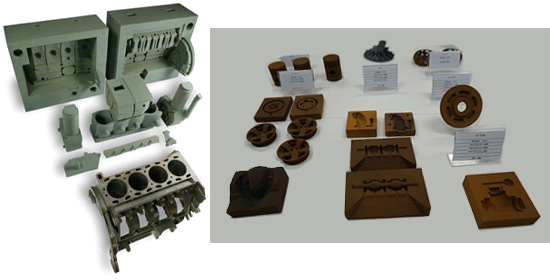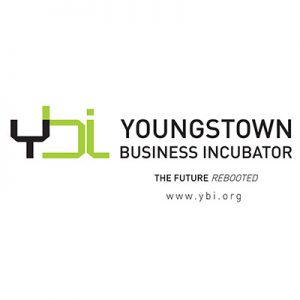


Sample components produced with next generation sand printer utilizing flexible printer settings to optimize and reduce the volume of sand required, minimizing production time and cost.
This project seeks to develop and demonstrate fast 3D sand printing technology hardware that would be affordable to small and medium-sized enterprises while developing a knowledge-base of design rules to enable design optimization in metal casting to reduce overall manufacturing costs.
Problem
Cast assemblies are often a barrier to vehicle platform innovation due to long lead times and affiliated cost to develop hard tooling. Critical cast assemblies required to maintain readiness for military platforms represent supply chain vulnerability due to lost tooling and reduced participation from small and medium enterprises (SMEs) in the defense casting supply chain. Additive manufacturing (AM) offers the potential to address these issues with design flexibility and shorter lead times. 3D sand printing (3DSP) can enable new casting designs with reduced mass, part consolidation, and complex fluid flow channels. Two key barriers to the adoption of AM sand printing in the metal casting industry are costs (both capital and consumables) and
process speed.
Objective
The objective of this project was to accelerate and drive industry commercialization efforts involving sand printing for production of lighter castings which would result in vehicle platform innovation while increasing U.S. manufacturing efficiency. The project strived to demonstrate fast printing technology hardware that is affordable to the domestic metal casting supply chain; develop knowledge-based design rules to enable a culture change and break the cycle of designing AM parts like cast or machined parts; and execute industry-valued workforce outputs to accelerate widespread technology applications and support regional manufacturing systems integration.
Technical Approach
Tinker Omega continued to evolve a next generation binder jetting of sand approach to facilitate SMEs’ utilization of multiple open-source bonding resins and aggregates meeting both regulatory requirements and casting process needs. These new printer systems promise to be more affordable both at initial purchase as well as during operation via an open source approach to consumables utilization. The University of Northern Iowa (UNI) assessed Tinker’s molds against industry standards and sand molds/cores produced by Viridis3D. UNI and Pennsylvania State University advanced the initial development of knowledge-based rules for casting design optimization. The American Foundry Society (AFS) developed e-learning modules and instructor-led training to facilitate education of new workers in this space.
Accomplishments
Assessment of two emerging hardware platforms demonstrated some of the challenges in increasing printer speed while maintaining dimensional tolerances for tooling. Outputs showed successful demonstration of advanced manufacturing supply chain capabilities in which large format sand printers may facilitate part count/core consolidation in the serial production of lightweight castings. For the complex automotive aluminum engine head, a 5 to 3 core consolidation was achieved. Downstream impacts of this include reduced stacking tolerances, less foundry labor, and potential for improved part quality and simplified life cycle sustainment. Global demand for affordable and fast printers is driving internal investment and in 2019 at least two offshore vendors launched new hardware. The consumables research, integrated sensor investigation, software enablers, and workforce development products from this project will augment new hardware approaches. 3DSP manufacturers will continue to optimize and refine their current product lines to increase speed, improve dimensional tolerances, and reduce initial and operating costs.
As of 2019 print speed and cost levels may accommodate rapid prototyping and serial production for volumes of 2000 units or lower based on geometry. A mold package produced by a Viridis3D prototype machine provided a 3X faster cycle time compared to a well-known OEM competitor. Dimensional tolerances, however, were not verified. At the time of project completion, these printers were being marketed at 60% or less cost as compared to the OEM competitor. Acceleration of industry commercialization efforts involving the use of sand printing was shown through the procurement of two additional large format printers by Humtown Products based on increased orders to support cast part production for automotive and equipment manufacturing. Another small business participant increased engineering staffing in order to provide 3D printed mold design services. The AFS leveraged the workforce content development within the project and offered the education products to SMEs interested in printed mold production.
Project Participants
Project Principal

Other Project Participants
- Tinker Omega Manufacturing LLC
- Youngstown State University
- University of Northern Iowa
- America Foundry Society
- Humtown Products
- Ford Motor Company
- Pennsylvania State University
- Product Development & Analysis, LLC
- Northern Iowa Community College
- Crescent Pattern
- American Foundry Society
Public Participants
- U.S. Department of Defense
- National Science Foundation
- U.S. Department of Energy
